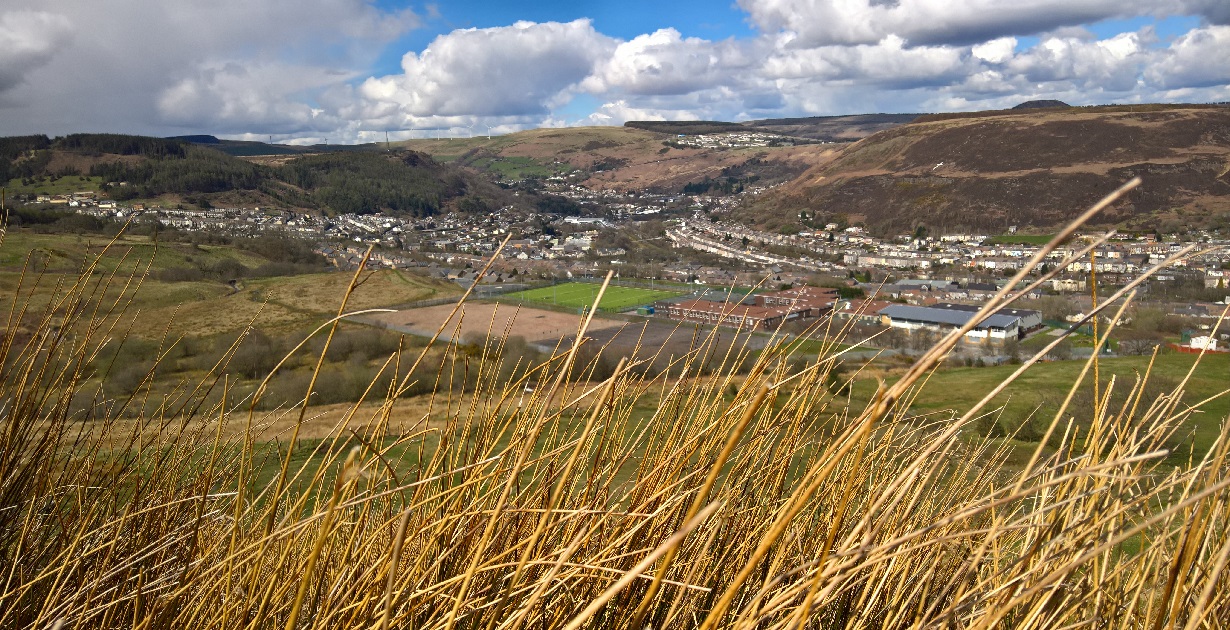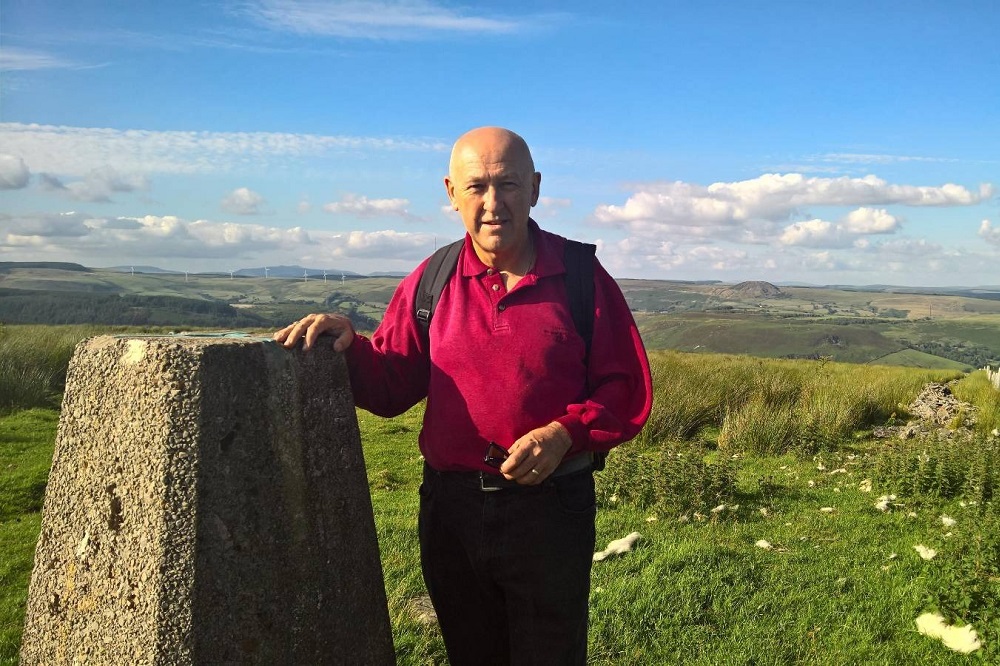Let’s walk up the mountain – It’s something lots of us do in the Rhondda

Continuing our autumn series by John Geraint, author of ‘The Great Welsh Auntie Novel’, and one of Wales’s most experienced documentary-makers. ‘John On The Rhondda’ is based on John Geraint’s popular Rhondda Radio talks and podcasts.
John Geraint
Will you come for a walk with me? Oh, I know it’s a bold thing to ask, but come on, let’s pretend we’re teenagers again, you and me. We’ll head up the mountain. It’s something lots of us do in the Rhondda. It gets us out of the urban sprawl of the Valley floor.
There’s a place up there – ‘Carncelyn’ I call it, though ‘Mynydd Penygraig’ is what it says on the maps – that’s got something really special about, something magical, something you’ll hardly believe. I’m not sure I believe it myself.
We’ll set off from the house where I grew up, on Tylacelyn Road, just below Penygraig Rugby Club. Let’s go the back way, up the garden steps, out into the back lane, up the gwli, all along Hughes Street, to the bottom of Gilfach Road.
You’ll feel the steep gradient start to burn in your leg muscles now, but we can count off the side streets as we climb past them: Penmaesglas, Wyndham, Mikado, Penpisgah, Thomas Street. Phew!
Have a whiff, because there’s lots more climbing to do: up that rough and twisting lane, in between the dry-stone walls, a little bit of pre-Industrial Rhondda, and out onto the bare mountain itself. This is the ridge where Carncelyn Farm once stood.
A century ago, we’d have seen the boxer Tom Thomas here, training for another bout, sparring with a bull, or so they said.
Credulous delight
When I was a boy – which was less than a century ago! – we’d have had to skirt round a huge a pyramid of coal waste at this point, the Black Tip. How many times did I slide down that Everest, nothing but a cardboard box for a toboggan?
Beyond it was the Top Feeder, a gloopy, algae-infested colliery pond said to have sacks and sacks of unwanted puppies and kittens resting in its depths. It was used, all the same, by boys more daring than me as a summer swimming pool.
These days, we can just go straight up towards the summit on the old parish road. It’s just a farmer’s track really, but we used to call it ‘the Roman Road’ – as straight as any the Romans built, it is, though it must have been made a thousand years after the legions had left Wales.
Local legend, fanciful but passed on with credulous delight by us nippers, claimed that an invading Roman army had marched down this very road to find the men of the valley below away hunting.
The legionaries slaughtered the defenceless women and children, but then the men came home and slaughtered them. In some versions of the tale, the foreign raiders were Saxons, but the result was the same.
So here we are, we’ve conquered the worst of the ascent. Let’s stop to regain our breath.
The whole sweep of mid-Rhondda is laid out beneath us now. Clydach Vale and Blaenclydach far left, then Glyncornel and Llwynypia, Pontrhondda and Tyntyla; lower Ystrad with Penrhys sitting above it; the long reach of Trealaw below the mountain opposite, from Ynyscynon down to Llethrddu cemetery and onwards to Mount Pleasant in Porth; then back around through Dinas and Williamstown, Craig-yr-Eos crowning the closer slopes to the right; finally, directly below us, the massed terraces of Penygraig and Tonypandy.

Final crest
On a map, I like to think, Rhondda presents two fingers to the world. Two fingers, one slightly fatter and longer than the other. Little Rhondda and Big Rhondda. Rhondda Fach and Rhondda Fawr.
Dearest Rhondda and Rhondda the Great. What we’re looking at is the knuckle of the fatter finger, mid-Rhondda, the heart of the Rhondda Fawr.
Onwards. We’re reaching the final crest now, so let’s veer left, off the track, over the mossy grass.
If it’s not too damp, we can honour another childhood tradition of mine and throw ourselves down for a rest on the springy turf of a small hollow, the Crow’s Nest. I remember flopping here the first time I ever made this climb, with a gang of older children from Hughes Street.
It seemed like a great adventure – I’d only just started walking to school on my own. It was a hot day, and Mam had filled my toy plastic water-bottle with weak orange-squash so that I wouldn’t die of thirst.
By the time I reached the Crow’s Nest, the contents tasted more of plastic than of orange. Even now, I can still feel it coating my tongue.
But we’re not finished yet, there’s another hundred yards to go, up to the Triangulation Stone. Now you can see Evanstown and Garden Village and Gilfach Goch itself down below us.
And southwards, the rich farmlands of the Vale of Glamorgan, the flats and office blocks of Cardiff, the coast at Barry, Aberthaw and Southerndown.
And there’s the Bristol Channel sparkling in the sunshine, Flat Holm and Steep Holm all ashimmer, the dark Somerset hills in plain sight on the far side.

Cardinal points
And now – here’s the thing, the thing that always gives me a thrill.
We’ll go right up to the Trig Point itself and touch the tapered concrete pillar. Now, stretch out both your arms, at the height of your shoulders and squarely to each side of your body, so that your open hands are lined up precisely with two cardinal points of the compass, East and West.
Because this is a magical place. Not that we’ve climbed any great height, just 1300 feet above sea level, that’s all; but there’s an extraordinary fact that I was always told about this spot.
If you go due east from here, on exactly this line of latitude, you’ll pass the lower reaches of Gwent, run north of the Cotswolds into the flatlands of southeast England, cross the North Sea into the Netherlands and traverse a vast swathe of the Continent… all before you ever stand as high as this again. By then, you’d be in the Urals!
And strangely, in the same manner, heading due west at this precise latitude, there’s no spot in Wales, the south of Ireland or eastern Canada that’s as high as the place where we’re standing right now, not until you come to the Rockies, thousands and thousands of miles away.
One day, I must check out whether this is actually true. Or maybe I won’t. Maybe what’s important is that I think it’s true.
With arms outstretched like this, you can believe it too. You can feel a kind of connection, if not to the whole wide world, then to enough of it to make it seem as if you’re reaching out to embrace humanity in all its rich diversity.
And you’re doing that from this one spot above the Rhondda.
‘John On The Rhondda’ is broadcast at about 3.15pm as part of David Arthur’s Wednesday Afternoon Show on Rhondda Radio
All episodes of the ‘John On The Rhondda’ podcast are available here
John Geraint’s debut in fiction, ‘The Great Welsh Auntie Novel’, is available from all good bookshops, or directly from Cambria Books
Support our Nation today
For the price of a cup of coffee a month you can help us create an independent, not-for-profit, national news service for the people of Wales, by the people of Wales.





No mention of all the damned wind turbines blighting the uplands of the Valleys!